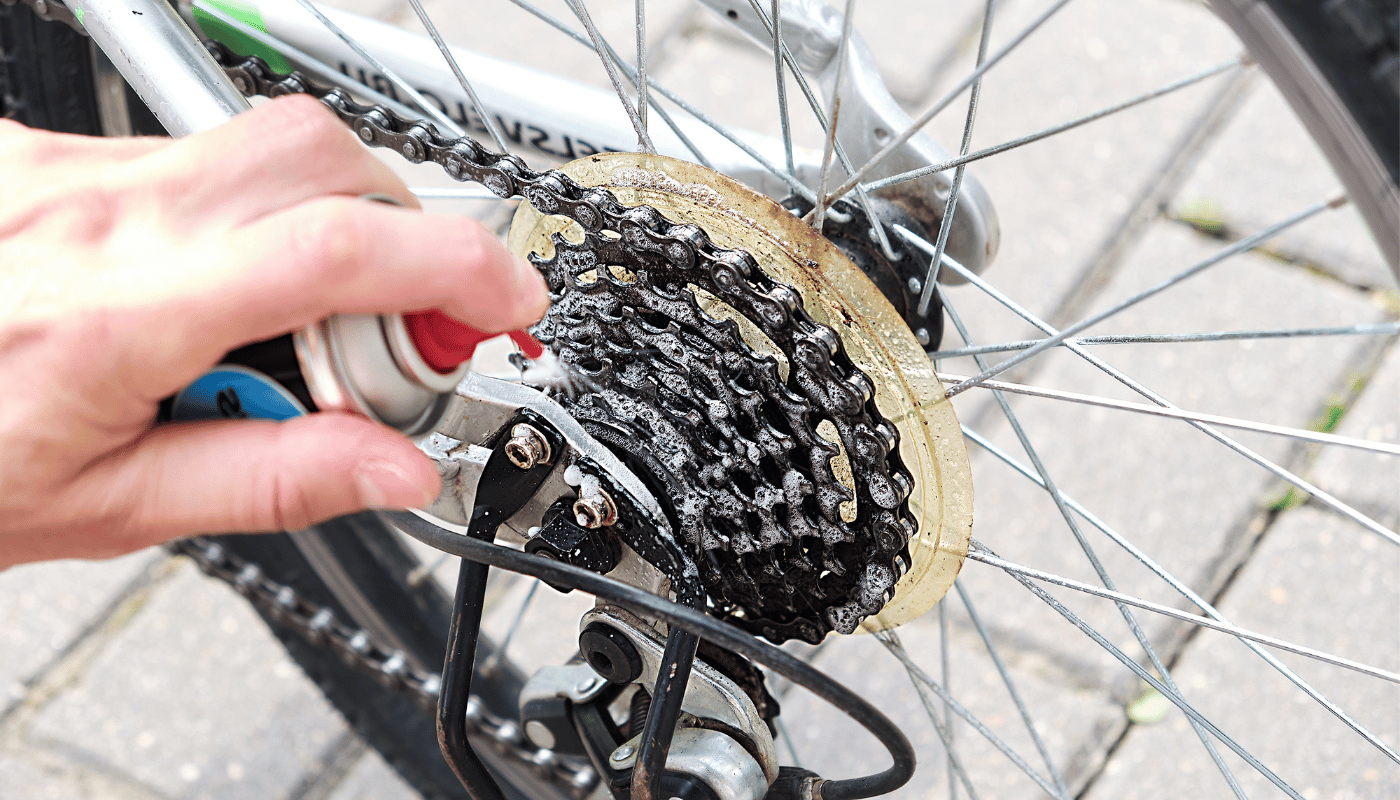Keeping your bicycle chain clean is not just about maintaining its appearance, but it’s also crucial for ensuring a smooth, efficient ride and prolonging the life of your bike. Whether you’re an experienced cyclist or a casual rider, learning the proper technique to clean your bicycle chain can make a significant difference in your biking experience. In this guide, we’ll walk you through the steps required to get your chain looking and functioning like new, so you can get back to enjoying your rides without any hitches.
Preparing Your Cleaning Workspace
Before diving into the intricate process of cleaning your bicycle chain, setting up an efficient and safe workspace is paramount. This initial step is not merely about finding a spot; it involves crafting an environment that enhances both the effectiveness of your cleaning efforts and the longevity of your bike components. The right workspace ensures you’re not just removing grit and grime but also preserving the integrity of your bicycle chain and gears for future rides.
First and foremost, select an area that is well-ventilated and spacious enough to maneuver around your bike comfortably. Adequate ventilation is crucial to disperse any chemical fumes from degreasers or cleaners used during the process. A garage or outdoor space can serve well, provided that the weather is conducive. Moreover, the surface should be solid and flat to prevent your bike from tipping over. An uneven ground can complicate the cleaning process and even cause damage to your bicycle.
Next, gather all necessary tools and cleaning solutions before you begin. This preparation step saves time and ensures a smooth cleaning session. Your toolkit should include a bike stand or a makeshift support to elevate your bicycle, making the chain more accessible. Quality degreasers, a chain brush or an old toothbrush, rags or towels, and lubricant are essential supplies. Organizing these items within arm’s reach streamlines the process, allowing you to focus on the task at hand without unnecessary interruptions.
Additionally, consider the cleanliness and orderliness of your workspace. A clutter-free area not only enhances safety but also makes it easier to spot and retrieve dropped components. Laying out a tarp or old newspapers underneath your working area can catch any drips or debris, simplifying cleanup afterwards. This preparation step underscores the importance of a methodical approach, ensuring that your cleaning efforts are both effective and efficient.
Lastly, donning appropriate attire is advisable. Old clothes or aprons, along with gloves, can protect your skin from harsh chemicals and keep your garments free from stains. Safety glasses are also recommended to shield your eyes from any splashing degreaser or lubricant. This protective measure is often overlooked but is vital in preventing accidents and ensuring a safe cleaning process.
| Tool/Supply | Purpose | Notes |
|---|---|---|
| Bike Stand | Elevate Bicycle | Makes chain accessible |
| Degreaser | Remove Grime | Eco-friendly options available |
| Chain Brush/Toothbrush | Clean Chain | Soft bristles to avoid damage |
| Rags/Towels | Clean and Dry Components | Use separate ones for cleaning and drying |
| Lubricant | Reduce Friction | Apply after cleaning |
Setting up a well-prepared workspace is the cornerstone of effective bicycle maintenance. It not only facilitates a thorough cleaning of the bicycle chain but also enhances the overall safety and enjoyment of the cleaning process. Taking the time to properly prepare your cleaning workspace pays dividends in the longevity and performance of your bicycle, ensuring that you can continue to enjoy smooth, efficient rides. Remember, a clean bike is a happy bike, and a happy bike leads to a happy rider.
Choosing the Right Cleaning Tools
Maintaining a clean bicycle chain is paramount for cyclists who wish to keep their bikes in top condition. The right cleaning tools not only simplify the cleaning process but also ensure the longevity of your bicycle chain. In this context, selecting the appropriate gear is as crucial as the cleaning process itself.
Firstly, a quality chain cleaner device is indispensable. This tool encases the chain, and, with the help of a solvent, scrubs off the grime from every link and roller. Secondly, a set of brushes specifically designed for bike maintenance can reach the nooks and crannies that are otherwise hard to clean, particularly between the chain links and the cassette. Lastly, a microfiber cloth is essential for wiping away the loosened dirt and drying the chain post-cleaning, ensuring no residue is left behind.
While there are numerous options available in the market, opting for tools that are durable and designed for bike maintenance can make a significant difference. Investing in high-quality tools will not only make the cleaning process more efficient but also protect your chain from potential damage caused by inadequate cleaning implements.
Further Insights on Cleaning Tools
Understanding the nuances of various cleaning tools can profoundly impact the efficacy of your bike maintenance routine. Each tool is designed with a specific purpose in mind, and knowing how to leverage these tools can significantly enhance your cleaning process. For instance, the design of a chain cleaner tool is such that it isolates the chain, allowing for a thorough clean without having to remove the chain from the bike. This not only saves time but also reduces the wear on the chain’s links.
Diving Deeper into Chain Maintenance
Delving deeper into chain maintenance, it’s crucial to acknowledge the role of lubrication post-cleaning. A properly cleaned chain sets the stage for optimal lubrication, which is essential for reducing friction and preventing rust. Thus, the cleaning tools you choose should be compatible with your bike’s specific needs and the type of lubricant you prefer using.
| Tool | Function | Benefits |
|---|---|---|
| Chain Cleaner Device | Encases and cleans the chain | Efficient, thorough cleaning without removal |
| Brushes | Cleans hard-to-reach areas | Enhanced cleanliness, extends chain life |
| Microfiber Cloth | Dries and polishes the chain | No residue, prevents rust |
| Degreaser | Breaks down grease and dirt | Prepares chain for lubrication |
| Lubricant | Reduces friction, protects from rust | Improves performance, extends chain life |
Choosing the right cleaning tools is not just about keeping your bicycle chain clean; it’s about safeguarding the overall health and performance of your bike. High-quality tools tailored to your bike’s requirements can significantly reduce maintenance time and enhance your cycling experience. Therefore, investing in the right tools is investing in the longevity and efficiency of your bicycle.
Step-by-Step Chain Cleaning Guide
Cleaning your bicycle chain is crucial for maintaining your bike’s performance and extending its lifespan. A clean chain reduces wear on your drivetrain and ensures smoother, more efficient rides. This guide will walk you through the process, ensuring you get professional results every time. First, gather your supplies: a chain cleaner or degreaser, a cleaning brush or old toothbrush, and some rags. You’ll also need lubricant to apply once the chain is clean.
Begin by applying the chain cleaner or degreaser to the entire length of the chain. Allow it to soak in for a few minutes to break down the grease and dirt. Next, use your brush to scrub the chain thoroughly, paying special attention to the links and rollers. This step is crucial for removing all the contaminants that can cause wear. Once scrubbed, rinse the chain with water (if your cleaner requires it) and dry it completely with a clean rag. The final step is to apply a suitable lubricant to the chain, ensuring it penetrates the links and rollers. Wipe away any excess lubricant to avoid attracting more dirt.
Choosing the Right Cleaning Supplies
Selecting the appropriate cleaning products is essential for effective chain maintenance. Options range from biodegradable degreasers to specialized chain cleaning solutions. Consider the type of riding you do and the conditions in which you typically ride when choosing your cleaning supplies.
Understanding Lubricant Types
Different riding conditions require different types of lubricants. For wet conditions, a thicker, more durable lubricant is best, while dry conditions call for a lighter, less sticky option. Understanding the distinction can significantly enhance your bike’s performance and reduce maintenance needs.
- Gather your cleaning supplies: degreaser, brush, and rags.
- Apply degreaser to the chain and let it soak.
- Scrub the chain thoroughly with the brush.
- Rinse (if necessary) and dry the chain completely.
- Lubricate the chain, paying attention to the links and rollers.
Lubricating Your Chain Post-Cleaning
Cleaning your bicycle chain is paramount for maintaining optimal performance and longevity of your bike. However, the process doesn’t end with just removing dirt and grime. The next critical step is lubricating your chain to ensure smooth operation and to protect it from wear and corrosion. Choosing the right lubricant and applying it correctly can make a significant difference in how your bicycle performs and lasts over time.
Firstly, it’s essential to select a lubricant that’s suitable for your riding conditions. For instance, if you frequently ride in wet conditions, a wet lubricant will adhere better and offer more durable protection against moisture. Conversely, dry lubricants are ideal for arid environments as they attract less dust and dirt. After cleaning your chain thoroughly and ensuring it’s dry, apply the lubricant evenly across the entire length of the chain. It’s crucial to give the lubricant time to penetrate the inner workings of the chain links before wiping away any excess to prevent attracting dirt.
Regular lubrication is not just about maintaining the chain’s efficiency; it’s about safeguarding your cycling experience. A well-lubricated chain reduces the risk of chain snaps and excessive wear on your drivetrain components, ensuring that your ride is smooth and enjoyable. Moreover, this practice can significantly extend the life of your chain and drivetrain, saving you money and hassle in the long run.
- Choose the appropriate lubricant for your riding conditions.
- Clean and dry your chain thoroughly before applying lubricant.
- Apply the lubricant evenly across the entire chain.
- Allow time for the lubricant to penetrate the chain links.
- Wipe away any excess lubricant to prevent attracting dirt.
Choosing the Right Lubricant for Your Chain
Selecting the correct lubricant for your bicycle chain is a crucial decision that impacts the efficiency and durability of your bike. Various factors, including the typical riding conditions and the specific needs of your bicycle, play a significant role in this choice. Understanding the differences between wet and dry lubricants, and when to use each, can help you make an informed decision that enhances your cycling experience. Remember, the goal is not just to lubricate but to do so in a way that matches your riding environment and habits.
Maintaining a Clean Chain Regularly
Ensuring your bicycle chain remains clean is not just about aesthetics; it’s a critical aspect of maintaining your bike’s performance and longevity. Regular cleaning helps in removing the grime and dirt that accumulates over time, which if left unchecked, can significantly degrade your chain and the drivetrain. The process doesn’t need to be cumbersome. By incorporating a few straightforward steps into your routine, you can keep your chain in optimal condition, ensuring a smoother ride and prolonging the life of your bike components.
Starting with the right tools and cleaners is essential. Using a dedicated bike chain cleaner or a mild degreaser can make the job easier and more effective. After applying the cleaner, use a brush or a chain cleaning device to scrub off the dirt. Rinsing thoroughly and drying the chain before applying a suitable lubricant is crucial. This not only protects the chain from corrosion but also reduces the wear and tear caused by friction. Remember, a well-lubricated chain is quieter and more efficient, translating to better performance on the road or trail.
Regular maintenance goes beyond cleaning. Inspecting your chain for wear and tear and ensuring it’s properly adjusted are also key to a well-functioning bicycle. Over time, chains stretch and wear out, which can affect your biking experience. Thus, understanding when to clean and when it’s time for a replacement is vital for every cyclist.
Choosing the Right Tools and Lubricants
Having the correct tools and lubricants is essential in maintaining a clean chain. Different conditions require different types of lubricants. For example, wet conditions call for heavier, more durable lubricants, while dry conditions are best suited for lighter, wax-based lubricants. Equipping yourself with a chain checker tool can also help in determining the right time for a chain replacement, ensuring your bike is always in top condition.
| Tool/Lubricant | Use Case | Frequency of Use |
|---|---|---|
| Chain Cleaner | Cleaning | Every 100-200 miles |
| Brush/Chain Cleaning Device | Scrubbing | As needed |
| Mild Degreaser | Deep Cleaning | Every 2-3 months |
| Wet Lubricant | Wet Conditions | Before each wet ride |
| Dry Lubricant | Dry Conditions | Before each dry ride |
In conclusion, maintaining a clean chain is an integral part of bicycle upkeep that should not be overlooked. Regular cleaning and lubrication not only enhance the performance and efficiency of your bike but also prevent premature wear and tear. By dedicating a small amount of time to this task, you can enjoy smoother rides and extend the lifespan of your bicycle components. Embracing these practices will ensure your cycling adventures are both enjoyable and hassle-free.





